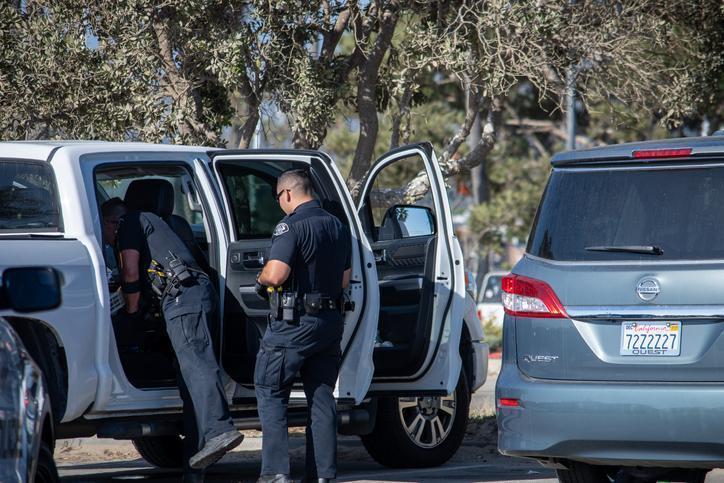

- Ref # CAB00235
- February 17, 2024
When a Vehicle is Used in a Crime, Do You Need a Warrant to Search It?
From the Classroom: Vehicle as an Instrumentality of a Crime
By Ray Hill
Professor Emeritus, Santa Rosa Junior College
A predator kidnaps a girl at knifepoint while she was walking home from school. He forces her into his vehicle. He drives to a secluded location where he rapes her. The victim is released. Based on the victim’s description and a multi-jurisdictional broadcast, the suspect and his vehicle are observed two days later parked a block away from another school in another city. The suspect is arrested and his vehicle impounded.
May the suspect’s vehicle be subject to a warrantless forensic examination for physical evidence (“theory of transfer”) or because the vehicle has been immobilized, must a search warrant be obtained
Under these circumstances, no search warrant is required by case law. The vehicle falls under the “Instrumentality of a Crime” doctrine. Officers may seize a vehicle that is itself a crime scene, take it to a secure location, and postpone a search until a proper scientific examination can take place (North v. Superior Court (1972) 8 Cal.3d 301).
The “Instrumentality of a Crime” doctrine applies when there is a “fair probability” or “substantial chance” that physical evidence (such as fibers, blood, semen, hairs, fingerprints, etc.) is inside a vehicle or when other physical evidence will be found on or inside a vehicle.
Examples: hit-and-run, expended shell casings or other ballistic evidence in a drive by shooting, vehicle striking another in an assault with a deadly weapon case, accident reconstruction in murder-second implied malice, or vehicle manslaughter case.
The scope of this search is limited to the nature of the evidence relating to the crime that prompted the search.
The “instrumentality” rule differs from the “probable cause” or “auto exception” rule, in the at the latter is a search for fruits, instrumentalities, or contraband in the vehicle related to criminal activity.
Examples of “Instrumentality of a Crime” Case Law
-
The defendant was a suspect in a murder case. Los Gatos police impounded his vehicle for evidence processing. The car was held for 24 days. Biological evidence was found in the trunk linking the defendant to the crime. With probable cause, a seized vehicle can be subjected to a forensic examination for whatever time is reasonably necessary. Given the nature and complexity of a murder investigation, the length of time in holding the car was not unreasonable (Peo. v. Nasmeh (2007) 151 Cal. App. 4th 85).
-
A search for forensic evidence that placed the victim inside a car at the time he was shot was permissible 10 days after vehicle impound (Peo. v. Teale (1965) 70 Cal. 3d. 497).
- It is permissible to take a paint scraping from the driver’s door and remove a fender to inspect and confirm the coat of paint underneath matched that of a stolen car (Peo. v. Robinson (1989) 209 Cal. App. 3d 1048).
-
Blood sample collection from a suspected murderer’s trunk (Peo. v. Griffin (1988) 46 Cal. 3d 1017).
-
Seizing a vehicle used to run over a murder victim (Peo. v. Robinson (1974) 41 Cal. App. 658).
-
A search inside a van where the victims were raped, tortured and murdered (Peo. v. Bittaker (1989) 48 Cal. 3d. 1046).
-
Search of the interior of a van used as a mobile photography studio for child pornography (Peo. v. Rogers (1978) 21 Cal. 3d. 542).
-
Downloading and viewing of speed and braking data from the “sensing and diagnostic module” (SDM) or “black box” in a vehicle manslaughter investigation (Peo. v. Diaz (2013) 213 Cal. App. 4th 743).
-
Examining tires and taking exterior paint scrapings from a car that was used to push a murder victim’s vehicle over a cliff (Cardwell v. Lewis (1974) 417 U.S. 583).
-
Seizing evidence of collision damage from a hit-and-run vehicle (Peo. v. Rice (1981) 126 Cal. App. 3d 477).
A vehicle is not an “instrumentality of a crime” simply because it provides transportation to and from a crime scene. There must be a “fair probability” that forensic evidence relating to the crime is inside or on the vehicle (Peo. v. Minjares (1979 24 Cal. 3d. 410).
See also Bob Phillips “The Fourth Amendment and Search and Seizure – An Update,” 23rd Edition, February 2023, Pages 144-1443 and cases cited from Devallis Rutledge “One Minute Brief – The Instrumentality Exception” #2019-12, 5/18/2019 on LegalUpdates.com.
Follow Your Policies
Follow your agency protocols in this type of investigation: incident command; securing and preservation and chain of custody of the vehicle; calling out trained personnel for evidence collection.
Smaller agencies may have to rely on a larger agency for assistance. Generalist agencies can use the California Department of Justice Bureau of Forensic Service Field Support Unit, where criminalists and investigators can provide local law enforcement agencies with on-site investigative support.
Consider Seeking a Warrant
With all this said, if your investigation will lead to seeking a search warrant for other premises or locations and there is no risk to evidence preservation, consider placing the authority to do a search of the vehicle in your warrant affidavit. A search warrant carries the presumption of lawfulness. The defense now has the burden of proving the search was unlawful.
Also, the “Good Faith Exception to the Exclusionary Rule” applies (United States v. Leon (1984) 468 U.S. 897; Massachusetts v. Shepard (1984) 468 U.S. 981). “Good faith” occurs when an officer prepares an affidavit with all relevant information available, doesn’t misstate or omit material facts, a magistrate reads the affidavit and signs the warrant, and the officer relies on the warrant in the recovery of evidence. If it is determined that there was a technical error in the warrant preparation or the “first-reviewed” probable cause is questioned by another magistrate, the search warrant cannot be overturned.
Stay Safe,
RH







